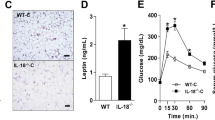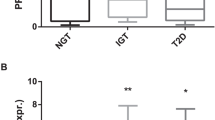Abstract
Background/Objectives:
In obesity, B cells accumulate in white adipose tissue (WAT) and produce IgG, which may contribute to the development of glucose intolerance. IgG signals by binding to Fcγ receptors (FcγR) and by activating the complement system. The aim of our study was to investigate whether activation of FcγR and/or complement C3 mediates the development of high-fat diet-induced glucose intolerance.
Methods:
We studied mice lacking all four FcγRs (FcγRI/II/III/IV−/−), only the inhibitory FcγRIIb (FcγRIIb−/−), only the central component of the complement system C3 (C3−/−), and mice lacking both FcγRs and C3 (FcγRI/II/III/IV/C3−/−). All mouse models and wild-type controls were fed a high-fat diet (HFD) for 15 weeks to induce obesity. Glucose metabolism was assessed and adipose tissue was characterized for inflammation and adipocyte functionality.
Results:
In obese WAT of wild-type mice, B cells (+142%, P<0.01) and IgG (+128% P<0.01) were increased compared to lean WAT. Macrophages of FcγRI/II/III/IV−/−mice released lower levels of cytokines compared to wild-type mice upon IgG stimulation. Only C3−/− mice showed reduced HFD-induced weight gain as compared to controls (−18%, P<0.01). Surprisingly, FcγRI/II/III/IV−/− mice had deteriorated glucose tolerance (AUC +125%, P<0.001) despite reduced leukocyte number (−30%, P<0.05) in gonadal WAT (gWAT), whereas glucose tolerance and leukocytes within gWAT in the other models were unaffected compared to controls. Although IgG in gWAT was increased (+44 to +174%, P<0.05) in all mouse models lacking FcγRIIb, only FcγRI/II/III/IV/C3−/− mice exhibited appreciable alterations in immune cells in gWAT, for example, increased macrophages (+36%, P<0.001).
Conclusions:
Lack of FcγRs reduces the activity of macrophages upon IgG stimulation, but neither FcγR nor C3 deficiency protects against HFD-induced glucose intolerance or reduces adipose tissue inflammation. This indicates that if obesity-induced IgG contributes to the development of glucose intolerance, this is not mediated by FcγR or complement activation.
This is a preview of subscription content, access via your institution
Access options
Subscribe to this journal
Receive 12 print issues and online access
$259.00 per year
only $21.58 per issue
Buy this article
- Purchase on Springer Link
- Instant access to full article PDF
Prices may be subject to local taxes which are calculated during checkout






Similar content being viewed by others
References
Xu H, Barnes GT, Yang Q, Tan G, Yang D, Chou CJ et al. Chronic inflammation in fat plays a crucial role in the development of obesity-related insulin resistance. J Clin Invest 2003; 112: 1821–1830.
Arkan MC, Hevener AL, Greten FR, Maeda S, Li ZW, Long JM et al. IKK-beta links inflammation to obesity-induced insulin resistance. Nat Med 2005; 11: 191–198.
Ouchi N, Parker JL, Lugus JJ, Walsh K . Adipokines in inflammation and metabolic disease. Nat Rev Immunol 2011; 11: 85–97.
Weisberg SP, McCann D, Desai M, Rosenbaum M, Leibel RL, Ferrante AW Jr . Obesity is associated with macrophage accumulation in adipose tissue. J Clin Invest 2003; 112: 1796–1808.
van Beek L, van Klinken JB, Pronk AC, van Dam AD, Dirven E, Rensen PC et al. The limited storage capacity of gonadal adipose tissue directs the development of metabolic disorders in male C57Bl/6J mice. Diabetologia 2015; 58: 1601–1609.
Lumeng CN, Bodzin JL, Saltiel AR . Obesity induces a phenotypic switch in adipose tissue macrophage polarization. J Clin Invest 2007; 117: 175–184.
Talukdar S, Oh DY, Bandyopadhyay G, Li D, Xu J, McNelis J et al. Neutrophils mediate insulin resistance in mice fed a high-fat diet through secreted elastase. Nat Med 2012; 18: 1407–1412.
Liu J, Divoux A, Sun J, Zhang J, Clement K, Glickman JN et al. Genetic deficiency and pharmacological stabilization of mast cells reduce diet-induced obesity and diabetes in mice. Nat Med 2009; 15: 940–945.
Wu D, Molofsky AB, Liang HE, Ricardo-Gonzalez RR, Jouihan HA, Bando JK et al. Eosinophils sustain adipose alternatively activated macrophages associated with glucose homeostasis. Science (New York, N.Y.) 2011; 332: 243–247.
Seijkens T, Kusters P, Chatzigeorgiou A, Chavakis T, Lutgens E . Immune cell crosstalk in obesity: a key role for costimulation? Diabetes 2014; 63: 3982–3991.
Winer S, Chan Y, Paltser G, Truong D, Tsui H, Bahrami J et al. Normalization of obesity-associated insulin resistance through immunotherapy. Nat Med 2009; 15: 921–929.
Nishimura S, Manabe I, Nagasaki M, Eto K, Yamashita H, Ohsugi M et al. CD8+ effector T cells contribute to macrophage recruitment and adipose tissue inflammation in obesity. Nat Med 2009; 15: 914–920.
Winer DA, Winer S, Shen L, Wadia PP, Yantha J, Paltser G et al. B cells promote insulin resistance through modulation of T cells and production of pathogenic IgG antibodies. Nat Med 2011; 17: 610–617.
Alberts B JA, Lewis J, Raff M, Roberts K, Walter P . Molecular Biology of the Cell. Garland Science: New York, NY, USA, 2002.
Nimmerjahn F, Ravetch JV . Fcgamma receptors as regulators of immune responses. Nat Rev Immunol 2008; 8: 34–47.
Khokher MA, Dandona P . Insulin-like stimulatory effect of Fc fragments of human immunoglobulin G on rat adipocyte lipogenesis: indirect evidence for Fc receptor on adipocytes. J Clin Endocrinol Metab 1983; 56: 393–396.
Khokher MA, Dandona P, Janah S, Coulston GL . Insulin-like stimulatory effect of human immunoglobulin G on adipocyte lipogenesis. Diabetes 1981; 30: 1068–1071.
Palming J, Gabrielsson BG, Jennische E, Smith U, Carlsson B, Carlsson LM et al. Plasma cells and Fc receptors in human adipose tissue—lipogenic and anti-inflammatory effects of immunoglobulins on adipocytes. Biochem Biophys Res Commun 2006; 343: 43–48.
Mamane Y, Chung Chan C, Lavallee G, Morin N, Xu LJ, Huang J et al. The C3a anaphylatoxin receptor is a key mediator of insulin resistance and functions by modulating adipose tissue macrophage infiltration and activation. Diabetes 2009; 58: 2006–2017.
Duffaut C, Galitzky J, Lafontan M, Bouloumie A . Unexpected trafficking of immune cells within the adipose tissue during the onset of obesity. Biochem Biophys Res Commun 2009; 384: 482–485.
Huh JY, Kim JI, Park YJ, Hwang IJ, Lee YS, Sohn JH et al. A novel function of adipocytes in lipid antigen presentation to iNKT cells. Mol Cell Biol 2013; 33: 328–339.
Wolf D, Jehle F, Ortiz Rodriguez A, Dufner B, Hoppe N, Colberg C et al. CD40L deficiency attenuates diet-induced adipose tissue inflammation by impairing immune cell accumulation and production of pathogenic IgG-antibodies. PLoS One 2012; 7: e33026.
Ghetie V, Ward ES . Multiple roles for the major histocompatibility complex class I- related receptor FcRn. Annu Rev Immunol 2000; 18: 739–766.
van Lent P, Nabbe KC, Boross P, Blom AB, Roth J, Holthuysen A et al. The inhibitory receptor FcgammaRII reduces joint inflammation and destruction in experimental immune complex-mediated arthritides not only by inhibition of FcgammaRI/III but also by efficient clearance and endocytosis of immune complexes. Am J Pathol 2003; 163: 1839–1848.
Skogh T, Blomhoff R, Eskild W, Berg T . Hepatic uptake of circulating IgG immune complexes. Immunology 1985; 55: 585–594.
Rodriguez-Iturbe B, Haas M. Post-Streptococcal Glomerulonephritis. In: Ferretti JJ, Stevens DL, Fischetti VA (eds) Streptococcus pyogenes: Basic Biology to Clinical Manifestations. University of Oklahoma Health Sciences Center: Oklahoma City, 2016.
van Beek L, Vroegrijk IO, Katiraei S, Heemskerk MM, van Dam AD, Kooijman S et al. FcRgamma-chain deficiency reduces the development of diet-induced obesity. Obesity (Silver Spring, Md.) 2015; 23: 2435–2444.
Murray I, Havel PJ, Sniderman AD, Cianflone K . Reduced body weight, adipose tissue, and leptin levels despite increased energy intake in female mice lacking acylation-stimulating protein. Endocrinology 2000; 141: 1041–1049.
Chow WN, Lee YL, Wong PC, Chung MK, Lee KF, Yeung WS . Complement 3 deficiency impairs early pregnancy in mice. Mol Reprod Dev 2009; 76: 647–655.
Yliharsila H, Kajantie E, Osmond C, Forsen T, Barker DJ, Eriksson JG . Birth size, adult body composition and muscle strength in later life. Int J Obes 2007; 31: 1392–1399.
Cianflone K, Xia Z, Chen LY . Critical review of acylation-stimulating protein physiology in humans and rodents. Biochim Biophys Acta 2003; 1609: 127–143.
Murray I, Sniderman AD, Cianflone K . Mice lacking acylation stimulating protein (ASP) have delayed postprandial triglyceride clearance. J Lipid Res 1999; 40: 1671–1676.
Trcka J, Moroi Y, Clynes RA, Goldberg SM, Bergtold A, Perales MA et al. Redundant and alternative roles for activating Fc receptors and complement in an antibody-dependent model of autoimmune vitiligo. Immunity 2002; 16: 861–868.
Takai T, Ono M, Hikida M, Ohmori H, Ravetch JV . Augmented humoral and anaphylactic responses in Fc gamma RII-deficient mice. Nature 1996; 379: 346–349.
Mayer-Barber KD, Yan B . Clash of the Cytokine Titans: counter-regulation of interleukin-1 and type I interferon-mediated inflammatory responses. Cell Mol Immunol 2017; 14: 22–35.
Acknowledgements
We thank Fatiha el Bouazzaoui, Mattijs Heemskerk, Jill Claassens (Department of Human Genetics, LUMC, Leiden, The Netherlands), Marcel Camps (Department of Immunohematology and Blood Transfusion, LUMC, Leiden, The Netherlands), Lianne van der Wee-Pals and Trea Streefland (Department of Medicine, Division of Endocrinology, LUMC, Leiden, The Netherlands) for their excellent technical assistance. This work was supported by grants from the Center of Medical Systems Biology (CMSB), the Netherlands Consortium for Systems Biology (NCSB) established by the Netherlands Genomics Initiative/Netherlands Organization for Scientific Research (NGI/NWO), the Leiden University Medical Center and Rembrandt Institute of Cardiovascular Science (RICS). Jan Van den Bossche received a VENI grant from ZonMW (91615052) and a Netherlands Heart Foundation Junior Postdoctoral grant (2013T003). MRB is supported by the Dutch Diabetes Foundation (grant 2015.81.1808). PCNR is an Established Investigator of the Netherlands Heart Foundation (grant 2009T038).
Author information
Authors and Affiliations
Corresponding author
Ethics declarations
Competing interests
The authors declare no conflict of interest.
Additional information
Supplementary Information accompanies this paper on International Journal of Obesity website
Supplementary information
Rights and permissions
About this article
Cite this article
van Dam, A., van Beek, L., Pronk, A. et al. IgG is elevated in obese white adipose tissue but does not induce glucose intolerance via Fcγ-receptor or complement. Int J Obes 42, 260–269 (2018). https://doi.org/10.1038/ijo.2017.209
Received:
Revised:
Accepted:
Published:
Issue Date:
DOI: https://doi.org/10.1038/ijo.2017.209



